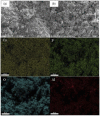Hydroxyapatite coating on an aluminum/bioplastic scaffold for bone tissue engineering
- PMID: 36320835
- PMCID: PMC9491302
- DOI: 10.1039/d2ra03285f
Hydroxyapatite coating on an aluminum/bioplastic scaffold for bone tissue engineering
Abstract
Three-dimensional printing can produce scaffolds with shapes and dimensions tailored for practical clinical applications. Enhanced osteoconductivity of such scaffolds is generally desired. Hydroxyapatite (HA) is an inorganic ceramic that can be used to coat such scaffolds and to accelerate healing during the bone restoration process. In this study, HA-coated aluminum/bioplastic scaffolds were fabricated, and their structural characteristics and osteoconductivity were evaluated. Aluminum/bioplastic scaffolds were fabricated by three-dimensional printing, and HA slurries with solids loadings of 10-20 vol% were used for coating. As solids loadings increased, the thickness of the coating layers slightly increased, whereas pore sizes decreased. The average compressive strength was comparable to that of cancellous bone. Potential osteoconductivity was tested by simulated body fluid immersion for 28 days, and the formation of the HA phase on the surface along with a weight increase indicates the potential bioactivity of the samples.
This journal is © The Royal Society of Chemistry.
Conflict of interest statement
There are no conflicts to declare.
Figures






















References
-
- Tariverdian T., Sefat F., Gelinsky M. and Mozafari M., Handbook of Tissue Engineering Scaffolds: Volume One, Elsevier, 2019, pp. 189–209
-
- Hutmacher D. W. Biomaterials. 2000;21:2529–2543. - PubMed
LinkOut - more resources
Full Text Sources
Research Materials

